Moderate overlap front: original test
Rating applies to 2004-07 models
Tested vehicle: 2004 Chevrolet Malibu LS 4-door
The Chevrolet Malibu was redesigned for the 2004 model year. The earlier design remained in production through the 2005 model year, but was called the Chevrolet Classic and was sold only to fleets.
| Overall evaluation | |
|---|---|
| Structure and safety cage | |
| Driver injury measures | |
| Head/neck | |
| Chest | |
| Leg/foot, left | |
| Leg/foot, right | |
| Driver restraints and dummy kinematics |
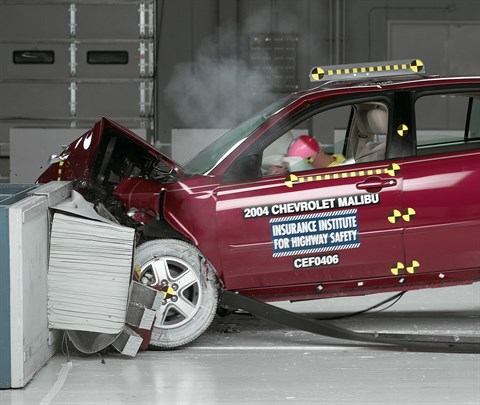
Action shot taken during the frontal offset crash test.
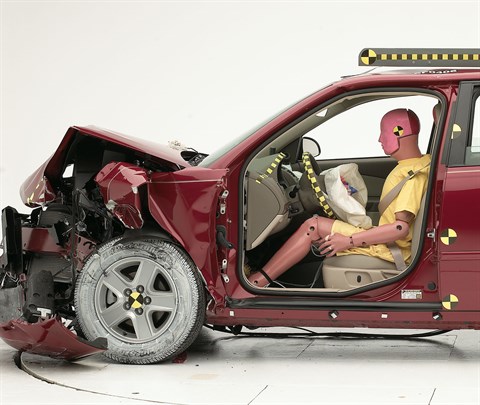
The dummy's position in relation to the steering wheel and instrument panel after the crash test indicates that the driver's survival space was maintained very well.
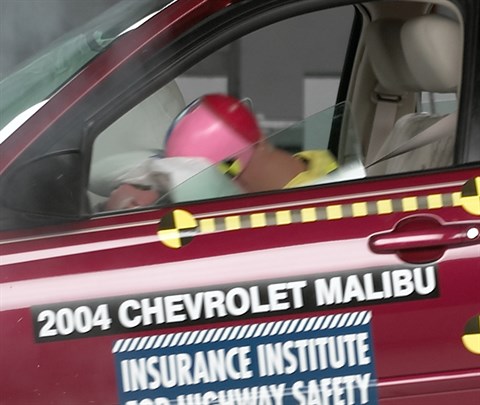
A high head acceleration occurred when the dummy's head bottomed out the airbag and hit the steering wheel.
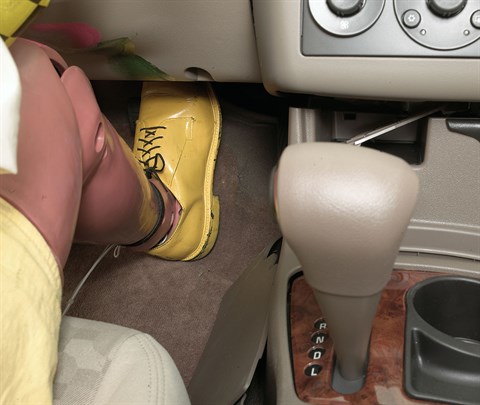
Forces on the right foot were just high enough to indicate the possibility of injury.
Measures of occupant compartment intrusion on driver side
| Test ID | CEF0406 |
|---|---|
| Footwell intrusion | |
| Footrest (cm) | 4 |
| Left (cm) | 7 |
| Center (cm) | 7 |
| Right (cm) | 7 |
| Brake pedal (cm) | 1 |
| Instrument panel rearward movement | |
| Left (cm) | 2 |
| Right (cm) | 2 |
| Steering column movement | |
| Upward (cm) | -3 |
| Rearward (cm) | 1 |
| A-pillar rearward movement (cm) | 1 |
Driver injury measures
| Test ID | CEF0406 |
|---|---|
| Head | |
| HIC-15 | 490 |
| Peak gs at hard contact | 93 |
| Neck | |
| Tension (kN) | 1.5 |
| Extension bending moment (Nm) | 16 |
| Maximum Nij | 0.31 |
| Chest maximum compression (mm) | 33 |
| Legs | |
| Femur force - left (kN) | 0.9 |
| Femur force - right (kN) | 2.0 |
| Knee displacement - left (mm) | 0 |
| Knee displacement - right (mm) | 0 |
| Maximum tibia index - left | 0.39 |
| Maximum tibia index - right | 0.73 |
| Tibia axial force - left (kN) | 2.5 |
| Tibia axial force - right (kN) | 3.1 |
| Foot acceleration (g) | |
| Left | 51 |
| Right | 152 |
Side: original test
Rating applies to 2004 models built after February 2004
Tested vehicle: 2004 Chevrolet Malibu LS 4-door with optional front and rear head curtain airbags
The Chevrolet Malibu was redesigned for the 2004 model year. The earlier design remained in production through the 2005 model year, but was called the Chevrolet Classic and was sold when new only to fleets.
All 2004-07 Malibu models manufactured after February 2004 include front door trim panel changes to improve occupant protection in side-impact crashes in cars equipped with optional side airbags. (Information about when a specific vehicle was manufactured is on the certification label typically affixed to the car on the driver door or adjacent B-pillar.) A further change was made beginning with 2005 models -- side airbags designed to protect drivers' and front passengers' torsos were added to the optional side curtain airbags available in 2004.
Two tests of a 2004 Malibu were conducted, one with an optional side curtain airbag for the driver and rear passenger, and one without. A third test of a Malibu, a 2005 model, was conducted because of the side airbag change. These three Malibus are rated separately, except that the structure ratings for the three vehicles are based on all three tests, and the rear passenger injury and head protection ratings are based on the two tests with side airbags.
| Overall evaluation | |
|---|---|
| Structure and safety cage | |
| Driver injury measures | |
| Head/neck | |
| Torso | |
| Pelvis/leg | |
| Driver head protection | |
| Rear passenger injury measures | |
| Head/neck | |
| Torso | |
| Pelvis/leg | |
| Rear passenger head protection | |
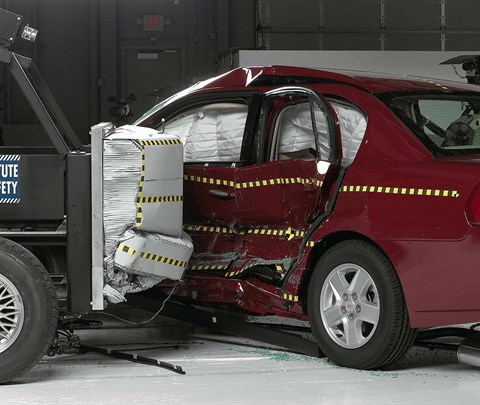
View of the vehicle and barrier just after the crash test.
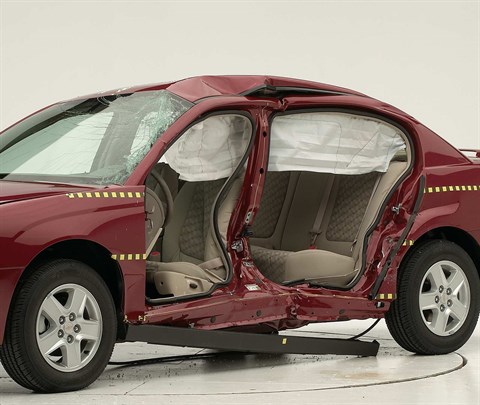
View of the vehicle after the crash with doors removed, showing the side airbag and damage to the occupant compartment.
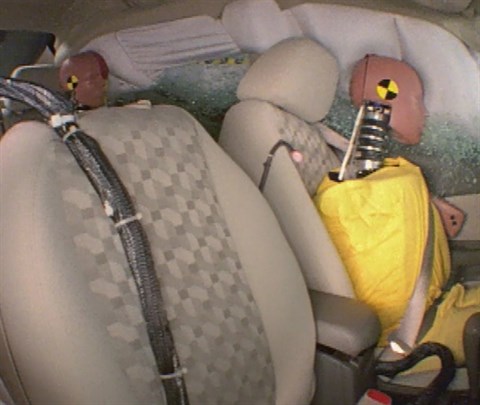
Action shot taken during the side impact crash test showing the driver dummy's head was protected from being hit by hard structures by the side curtain airbag.
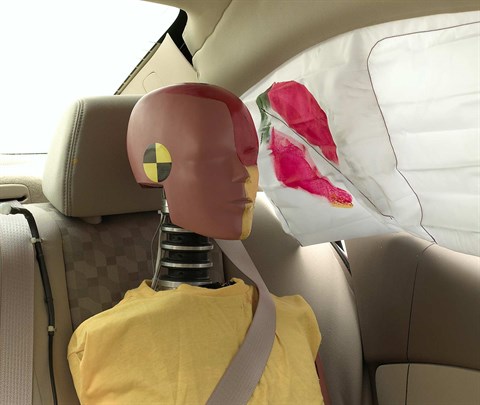
Smeared greasepaint shows where the rear passenger dummy's head was protected by the side airbag.
Measures of occupant compartment intrusion on driver side
| Test ID | CES0404 | CES0403 | CES0509 |
|---|---|---|---|
| B-pillar to longitudinal centerline of driver's seat (cm) | -5.0 | -5.0 | -5.5 |
| Negative numbers indicate the amount by which the crush stopped short of the seat centerline. | |||
Driver injury measures
| Test ID | CES0403 |
|---|---|
| Head HIC-15 | 532 |
| Neck | |
| Tension (kN) | 0.9 |
| Compression (kN) | 0.9 |
| Shoulder | |
| Lateral deflection (mm) | 63 |
| Lateral force (kN) | 2.8 |
| Torso | |
| Maximum deflection (mm) | 45 |
| Average deflection (mm) | 34 |
| Maximum deflection rate (m/s) | 5.29 |
| Maximum viscous criterion (m/s) | 0.97 |
| Pelvis | |
| Iliac force (kN) | 1.6 |
| Acetabulum force (kN) | 3.4 |
| Combined force (kN) | 4.6 |
| Left femur | |
| L-M force (kN) | 0.8 |
| L-M moment (Nm) | 103 |
| A-P moment (Nm) | 42 |
Passenger injury measures
| Test ID | CES0403 | CES0509 |
|---|---|---|
| Head HIC-15 | 94 | 174 |
| Neck | ||
| Tension (kN) | 0.1 | 0.9 |
| Compression (kN) | 0.5 | 0.2 |
| Shoulder | ||
| Lateral deflection (mm) | 34 | 29 |
| Lateral force (kN) | 1.5 | 1.5 |
| Torso | ||
| Maximum deflection (mm) | 36 | 35 |
| Average deflection (mm) | 28 | 27 |
| Maximum deflection rate (m/s) | 3.84 | 3.89 |
| Maximum viscous criterion (m/s) | 0.61 | 0.58 |
| Pelvis | ||
| Iliac force (kN) | 0.6 | 0.8 |
| Acetabulum force (kN) | 2.0 | 2.4 |
| Combined force (kN) | 2.1 | 2.8 |
| Left femur | ||
| L-M force (kN) | 0.5 | 0.5 |
| L-M moment (Nm) | 177 | 165 |
| A-P moment (Nm) | -43 | 35 |
Rating applies to 2004-06 models
Tested vehicle: 2004 Chevrolet Malibu LS 4-door without optional side airbags
The Chevrolet Malibu was redesigned for the 2004 model year. The earlier design remained in production through the 2005 model year, but was called the Chevrolet Classic and was sold when new only to fleets.
All 2004-07 Malibu models manufactured after February 2004 include front door trim panel changes to improve occupant protection in side-impact crashes. (Chevrolet reported that these door trim panel changes would not significantly affect side-impact performance in models without side airbags; therefore the overall side impact rating for all 2004-06 models without side airbags is the same.)
Two tests of a 2004 Malibu were conducted, one with an optional side airbag for the driver and rear passenger, and one without. A third test of a Malibu, a 2005 model, was conducted because the side airbags were changed beginning with 2005 models. These three Malibus are rated separately, except that the structure ratings for the three vehicles are based on all three tests.
Beginning with 2007 models, the side curtain airbags designed to protect drivers' and front and rear passengers' heads became standard, but side airbags designed to protect drivers' and front passengers' torsos remained optional.
| Overall evaluation | |
|---|---|
| Structure and safety cage | |
| Driver injury measures | |
| Head/neck | |
| Torso | |
| Pelvis/leg | |
| Driver head protection The dummy's head was hit by the intruding barrier, producing high head injury measures. |
|
| Rear passenger injury measures | |
| Head/neck | |
| Torso | |
| Pelvis/leg | |
| Rear passenger head protection The dummy's head was hit by the window sill and window frame of the rear passenger door, producing moderately high head injury measures. Hitting the window areas should be prevented. |
|
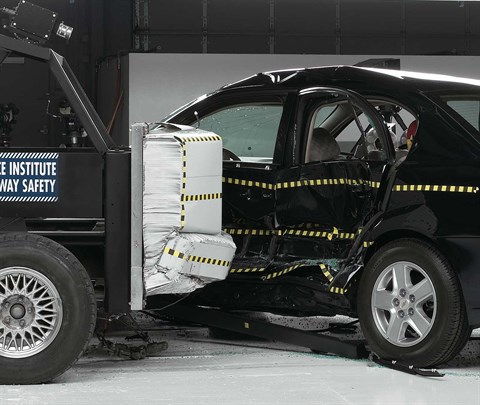
View of the vehicle and barrier just after the crash test.
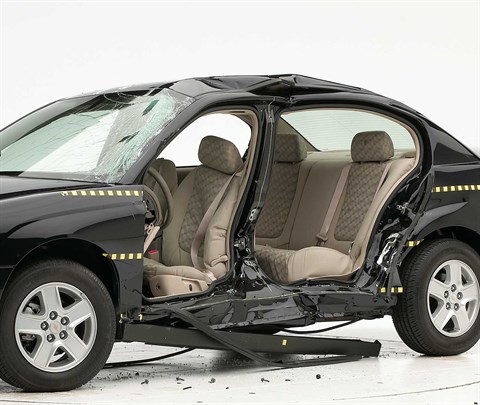
View of the vehicle after the crash with doors removed, showing damage to the occupant compartment.
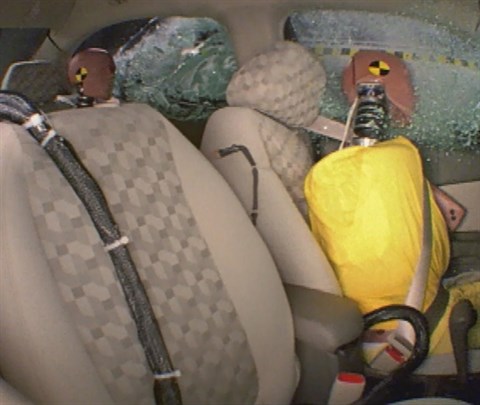
Action shot taken during the side impact crash test showing the driver dummy's head being hit by the intruding barrier.
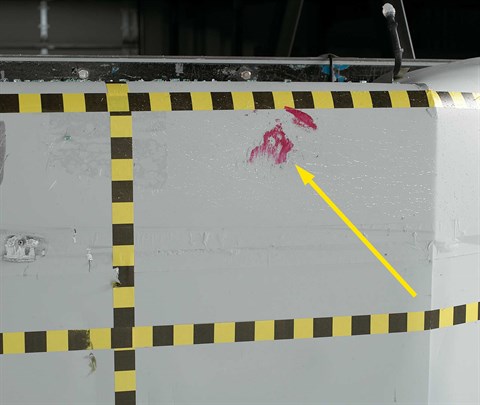
Smeared greasepaint indicates where the driver dummy's head hit the barrier.
Measures of occupant compartment intrusion on driver side
| Test ID | CES0404 | CES0403 | CES0509 |
|---|---|---|---|
| B-pillar to longitudinal centerline of driver's seat (cm) | -5.0 | -5.0 | -5.5 |
| Negative numbers indicate the amount by which the crush stopped short of the seat centerline. | |||
Driver injury measures
| Test ID | CES0404 |
|---|---|
| Head HIC-15 | 1,606 |
| Neck | |
| Tension (kN) | 2.0 |
| Compression (kN) | 1.3 |
| Shoulder | |
| Lateral deflection (mm) | 51 |
| Lateral force (kN) | 2.8 |
| Torso | |
| Maximum deflection (mm) | 48 |
| Average deflection (mm) | 39 |
| Maximum deflection rate (m/s) | 8.12 |
| Maximum viscous criterion (m/s) | 1.49 |
| Pelvis | |
| Iliac force (kN) | 2.8 |
| Acetabulum force (kN) | 3.8 |
| Combined force (kN) | 6.3 |
| Left femur | |
| L-M force (kN) | 0.8 |
| L-M moment (Nm) | 129 |
| A-P moment (Nm) | 42 |
Passenger injury measures
| Test ID | CES0404 |
|---|---|
| Head HIC-15 | 722 |
| Neck | |
| Tension (kN) | 1.9 |
| Compression (kN) | 0.1 |
| Shoulder | |
| Lateral deflection (mm) | 35 |
| Lateral force (kN) | 1.5 |
| Torso | |
| Maximum deflection (mm) | 38 |
| Average deflection (mm) | 30 |
| Maximum deflection rate (m/s) | 3.63 |
| Maximum viscous criterion (m/s) | 0.61 |
| Pelvis | |
| Iliac force (kN) | 1.1 |
| Acetabulum force (kN) | 2.5 |
| Combined force (kN) | 3.3 |
| Left femur | |
| L-M force (kN) | 0.3 |
| L-M moment (Nm) | 124 |
| A-P moment (Nm) | 31 |
Head restraints & seats
Seat type: All seats
| Overall evaluation | |
|---|---|
| Dynamic rating | |
| Seat/head restraint geometry |
| Seat type | All seats |
|---|---|
| Geometry | |
| Backset (mm) | 32 |
| Distance below top of head (mm) | 52 |
| Seat design parameters | |
| Pass/fail | Fail |
| Max T1 acceleration (g) | 12.1 |
| Head contact time (ms) | 71 |
| Force rating | 1 |
| Neck forces | |
| Max neck shear force (N) | 14 |
| Max neck tension (N) | 732 |
How the head restraint & seat test is conducted
Currently, IIHS tests apply only to front seats.
